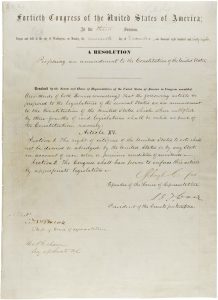The 15th: An Emerging Amendment?

It’s been 150 years since the ratification of the 15th Amendment to the United States Constitution on February 3, 1870.
Sometimes labelled as the last of the “Reconstruction Amendments,” this change to the law of the land ensured the voting rights for all male citizens and gave Congress the power to pass additional legislation to protect and ensure that right. (Voting rights for women came fifty years later in 1920 with the ratification of the 19th Amendment.)
Section 1. The right of citizens of the United States to vote shall not be denied or abridged by the United States or by any State on account of race, color, or previous condition of servitude.
Section 2. The Congress shall have power to enforce this article by appropriate legislation.
During the Civil War years and Reconstruction Era, civil and voting rights for freedmen were subjects of intense discussion. While the 13th Amendment abolished slavery and the 14th Amendment granted citizenship and equal protection under the law, the 15th Amendment was needed to further build and explicitly state voting rights.
In a political move, the Republican party saw franchised black male voters as a way to bolster their platform and get more votes, seats, and years in executive offices; they pressed for the amendment which was generally resisted by the South. Many whites in that region saw it as another “punishment” measure of the Reconstruction.
Ratified on February 3, 1870, the 15th Amendment became part of the Constitution a few weeks later on March 30. However, as one political saga closed another opened. The amendment was interpreted narrowly by the U.S. Supreme Court, allowing southern states to create laws which hindered voter registration and created barriers to actual voting. Poll taxes and literacy tests disenfranchised many black voters and white constituents with lesser means. Additionally, intimidation and violence kept voters away on election days and these practices were generally overlooked by the justice system.
Finally, in the 20th Century, courts began to dismantle the barriers and interpret the 15th Amendment more inclusively and according to intent. The Civil Rights Movement particularly addressed the inequalities faced at polling places, prompting a 1966 decision in Harper v. Virginia State Board of Elections to halt poll taxes in state elections. The previous year the Voting Rights Act of 1965 passed Congress; this allowed more federal oversight in elections to prevent discrimination and see that literacy tests and other forms of intimidation were not practiced.
The Civil War directly led to the creation of the 15th Amendment which was born in the Reconstruction Era. However, racial and social prejudice coupled with lack of strong enforcement hindered its protective ability for decades. During the Civil Rights Movement, the 15th Amendment finally matured, backed by courts and further protected by congressional legislation.
Perhaps this amendment can been seen as a long-term emerging effect of the Civil War. Unfortunately, it took a long time to reach enforcement…though, perhaps, that also can be viewed as an effect of the 1860’s armed conflict. Today, voting rights and voting access is still an important topic. A reminder of the living nature of the Constitution and continuing efforts to safeguard citizens’ freedoms.
Race and power trump sex. Interesting.